As life returns to somewhat normal and companies return to their pre-pandemic schedules, a new opportunity has emerged for the companies as well as their employees. During the pandemic, office spaces weren’t getting used and employees were working from home. Now that people return to their workplaces, companies are starting to realize that the futuristic hybrid workplace might be the new normal.
There are various reasons behind this realization. Contrary to expectations, when people were working from home, employee productivity increased instead of reducing. Executives have started considering hybrid workplaces in order to lower operational costs and increase employee happiness. Let us cover what hybrid workplaces are, as well as their accompanying challenges and opportunities.
What is a hybrid workplace?
A hybrid workplace introduces temporary workspaces, where employees don’t have to come to the workplace unless they need to. Employees do most of their work from their home, or someplace else. It also lets teams, that are distributed around the globe, collaborate as if they were in the same physical space.
In essence, hybrid workplaces combine all the advantages of remote working with the strengths of traditional workplaces. While they were initially used to ensure employee safety during the pandemic, it’s become clear that the hybrid workplaces are here to stay. The IBM Institute for Business Value 2020 CEO Study stated, “Remote work will be a permanent fixture as part of a hybrid workforce that blends in-person employees with virtual colleagues.”
However, hybridity comes with its own challenges. We’ll discuss a few of those.
Challenges associated with hybrid workplaces
First of all, space management is crucial; the reduced workspace may lower costs, but it has obvious limitations. The companies need to make sure that whatever office space they keep gives them the greatest return on investment. Secondly, connectivity is also an issue; employees who come to the office and employees who are working from home need to be connected seamlessly, so that the distance doesn’t affect the workflow. Lastly, a comprehensive system is needed to monitor the available workplace. This system needs to be easy to use, and it needs to adapt to the needs of the employees and employers.
An increasing number of companies are planning to switch to hybrid workplaces as they reopen. At the same time, employers are pondering how to address the challenges associated with the hybrid workplaces. That’s where Appspace comes in.
How can Appspace help?
After what we’ve discussed above, it’s clear that a complete solution is needed in order to address the following needs:
1. The available office space should get used to its fullest extent in order to provide the maximum return on investment.
2. On-site employees should be able to seamlessly communicate and work with their virtual colleagues.
3. This system needs to monitor the workspace and manage reservations. Office admins should be able to view and accept/reject requests for reservations.
Appspace does all this, and more. Best of all, the platform makes the transition to a hybrid workplace extremely simple by making sure that it can run on almost any hardware. Which is why nearly more than 3,000 companies worldwide and more than 145 of the Fortune 500 companies rely on Appspace to power their hybrid workplaces.
So what makes Appspace so special? I’ll cover some of its features.
Appspace Features:
Office Space Management
Appspace recently launched its space management features, which let employers create virtual maps of their floors, buildings, and campuses. Employees can then use these maps to reserve rooms, cubicles, or meeting rooms according to their needs. Office admins will get notified of employees’ requests for reservations and can accept or reject these requests.
Visitors and guests can also use these space management tools to get temporary building passes. Once they’re in the workplace, virtual maps help them find their way around. These maps can also be similarly used by employees to find each other, and for wayfinding.
Employee Communication
As mentioned earlier, a hybrid workplace cannot function without seamless employee communication. Appspace provides employees with the tools to communicate effectively by making sure that they can deliver the content they want to the right people at the right time. Using Appspace’s employee communication tools, it’s also extremely easy to visualize complex data using feeds curated for each industry. These data can then be communicated over with specific employees, or all over the company.
In addition, there’s support for integration with enterprise messaging apps like Webex Teams, Microsoft Teams, and Slack. Appspace can even publish content to multiple enterprise apps with one click, so you can reach everyone you need to.
Digital Signage
Digital signages can get extremely complicated, especially in companies that have their workforce distributed across the globe. With Appspace, it’s extremely easy to create digital signages without any coding or external software. After creating them, you can publish them to any region, group, meeting room, or device. The responsive designs adapt to all screens including mobiles, desktops, or tablets, so you never have to worry about creating a separate design for each one.
The hybrid workplace is an inevitability for a lot of companies in the future. However, a shift to hybridity is not possible without the proper technological tools to back it up. In this regard, Appspace provides companies will all the software they’d need to make the shift. What’s more, the company’s always at the forefront of new technological innovations, so you can be sure that your organization will always be using the latest technologies to power its hybrid workplace.
For more information, visit the Appspace website – Click Here
